How to Make Hard Apple Cider
If this is your first time making hard apple cider at home, I highly suggest starting with this half-gallon recipe. This way you can get acquainted with the process and taste test before committing to a large batch.
I plan on making a five-gallon batch before Christmas to give to friends and family!
Here is my Amazon list for brewing supplies. If you have a local home brew store, that is also an option to get what you need.
I got all of my supplies at my local homebrew store up the street from my house. At a homebrew store, you can have someone help you pick out the right supplies.
- 1/2 gallon glass jug (with a cap)
- a second 1/2 gallon glass jug (with cap)
- 1 rubber stopper for brewing – You will need to make sure it is the right size for your jug. Some jugs have different diameter openings. I’ve linked the size stopper that fits my 1/2 gallon glass jug.
- an S airlock for the stopper
- a funnel
- a small pot
- cheap vodka (for cleaning equipment)
- Two 1-Liter swing-top bottles (carbonation safe, for bottling the cider)


How to Make Hard Cider from Apple Juice
I think brewing at home intimidates a lot of people, so I made this recipe as easy as possible. So no, you don’t have to go pick and freshly juice your own organic apples in order to make cider. I would absolutely do this if I had my own apple tree, but I don’t.
With this recipe, you can just buy some organic apple juice at the store. I used the 365 brand of organic pressed apple juice from Whole Foods. It’s an unfiltered juice not from concentrate.
The juice must be 100% apple juice and free from any preservatives and additives. Also, make sure the juice does not have any added sugar.
Here are the ingredients you’ll need:
- 2 Grams Cider Yeast (Saccharomyces bayanus)
- 64 Fluid Ounces Organic Pasteurized Apple Juice
- Filtered Water
- Organic Brown Sugar or Organic Cane Sugar
- Cinnamon Stick (optional)
- Cloves (optional)
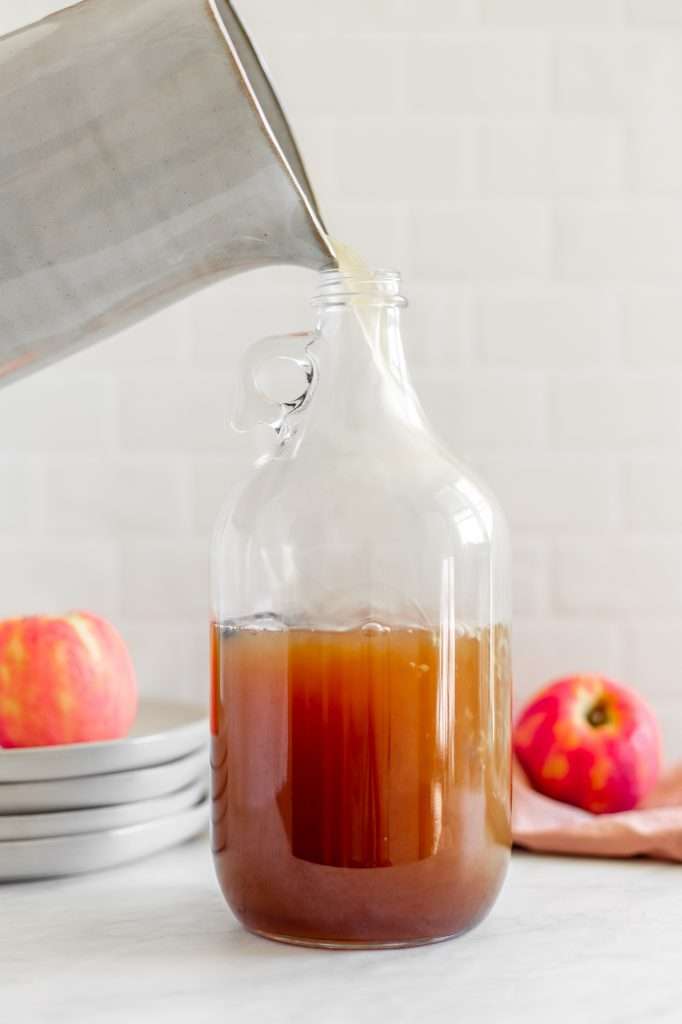

Can You Use Apple Juice Concentrate for Hard Cider?
Yes, you can use apple juice concentrate to make cider, but it needs to be 100% pure apple juice, with no other added ingredients.
It cannot have preservatives or added sugars. You will also need to reconstitute it according to the directions, and then boil it before using it in the recipe.
You can also use fresh pressed apple juice, but if you do you need to boil it or pasteurize it before using it.
Choosing Yeast for Sparkling Hard Cider
You can use champagne yeast or cider yeast for this recipe. If you visit a home-brew store, they should be able to help you select a cider yeast.
When buying packaged yeast, I like to make sure that the yeast species is not genetically modified. We chose to use Saccharomyces bayanus. This yeast species is found in association with the natural fermentation of grapes, and it’s great for cider fermentation.
Another option is to use wild yeast. You only need about two tablespoons of wild yeast starter in place of the yeast in the recipe. Click here to learn how to make a wild yeast starter.

The Benefits of Hard Apple Cider
Everyone knows that apples are a “superfood” loaded with beneficial vitamins and minerals. Well, fermentation can make all the benefits of apples more bioavailable.
When homemade with just apple juice, organic sugar, and yeast hard apple cider is a relatively healthy alcoholic beverage. Hard apple cider contains a lot of bioavailable vitamin C, potassium, and antioxidants. Plus, it’s gluten-free!
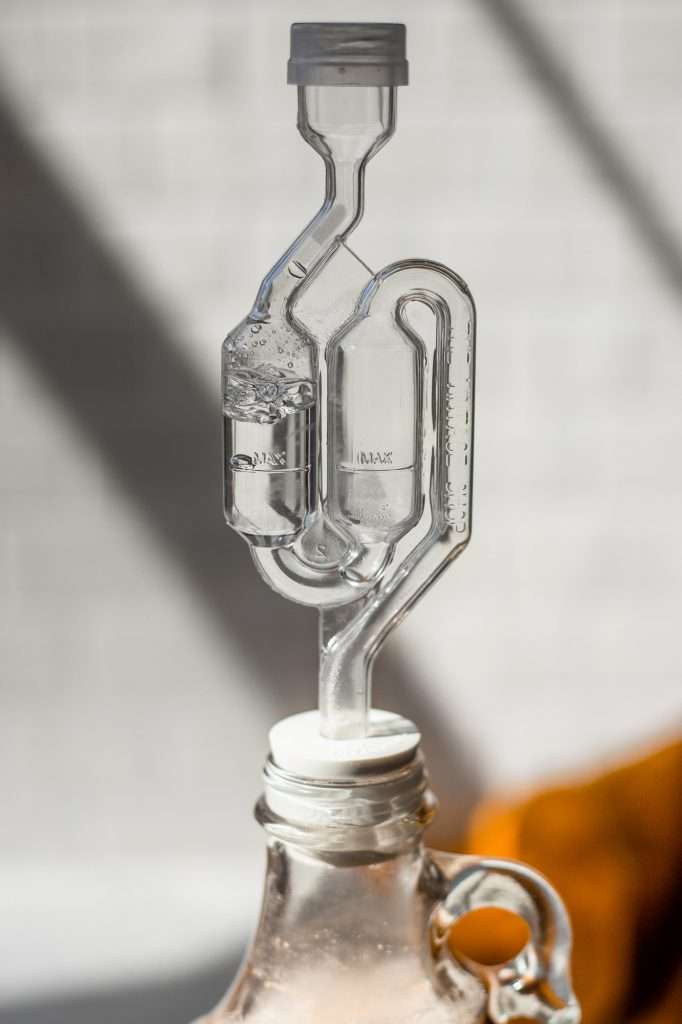
How to Bottle and Store Hard Apple Cider
Bottling and storing the cider is pretty easy. You need to verify that you have carbonation-safe bottles.
This is a sparkling hard cider, so we are going to carbonate it. To carbonate hard cider in the bottle, we have to add a small amount of sugar, called priming sugar, right before bottling. I like to use honey as priming sugar.
The yeast will feed on the freshly added sugar and produce more carbon dioxide. Since the cider is in carbonation-safe bottles with the cap secure, the CO2 is forced into the cider, and it becomes carbonated. Bottling 1 liter with only one tablespoon of honey is not enough sugar to excessively carbonate. It’s just enough to produce a pleasant level of carbonation.
To make this a still cider instead of sparkling cider, simply do not add any honey or sugar.
You’ll need:
- Two 1-Liter Swing top bottles(Carbonation Safe)
- Organic Honey
How to Bottle
- Clean and sterilize the bottles.
- Add one tablespoon of honey to each 1 Liter bottle.
- Using a funnel, transfer the cider from the aging jug into the carbonation-safe bale top bottles, leaving the sediment in the bottom of the jug.
- Cap the bottles and invert gently twice to mix the honey with the cider.
- Allow to ferment at room temperature for five to seven days, then immediately place in the fridge. You can age the cider for 3 more weeks in the fridge before enjoying it chilled.

More Fall Ferments to Try
- Sweet Sourdough Pumpkin Bread With Cinnamon and Pecans
- The Best Maple Pecan and Cinnamon Sourdough Bread Recipe
- Sparkling Golden Beet Kvass Made the Traditional Way
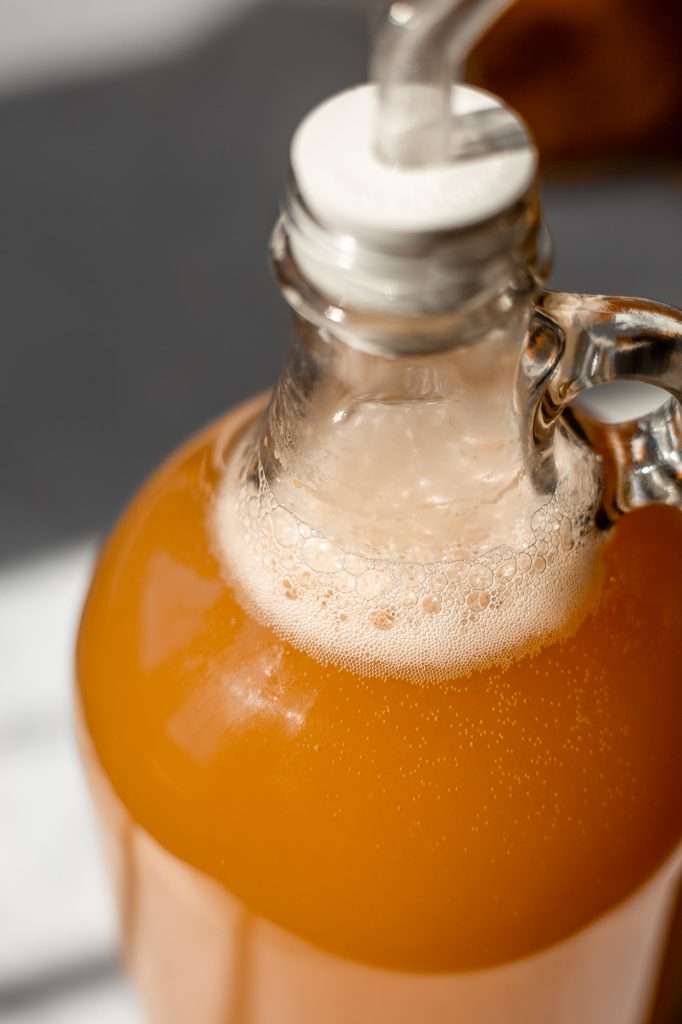
Sparkling Hard Cider from Apple Juice
This is a super simple recipe for DIY hard apple cider. You just need a few pieces of equipment, apple juice, yeast, and spices! This recipe comes together in just 15 minutes and ferments for about three weeks before aging and bottling.
- Prep: 15 minutes
- Cook: 5 minutes
- Total Time: 1008 hours 20 minutes
Ingredients
- 64 fl oz organic apple juice
- 75 grams organic brown sugar
- 1/2 tsp cinnamon chips (optional)
- 1 small clove (optional)
- 2 grams cider yeast
Instructions
- Clean and sanitize all of your equipment. I like to wash the jug with soap and water, allow it to air dry a bit, then rinse the jug with cheap vodka, and allow it to fully air dry.
- Once your equipment is prepped, bring 1 cup of water to a boil in a small sauce pan and dissolve the brown sugar in the water. Allow it to cool to room temp.
- Add the brown sugar water mixture to the jug.
- Add in the cider yeast and mix gently by swirling. Wait about 30 minutes for the yeast to get frothy and active.
- Carefully using a funnel, add the pasteurized apple juice to the jug leaving two inches of headspace (see pictures above)
- Add the cinnamon and clove (optional)
- Cap the jug and swirl it around for about a minute.
- Remove the cap and place the airlock and stopper in the jug (see pictures above).
- After a few hours, you should notice bubbling in the cider and activity in the airlock.
- Allow the cider to ferment for 7 to 14 days until the bubbling has completely stopped and you no longer see activity in the airlock. At this point, you should see sediment in the bottom of the jug.
- Remove the airlock and using a funnel, transfer the cider to a new, clean jug for aging. Be careful pouring, pour gently, leaving the sediment in the bottom of the original jug.
- Allow the cider to age at a cool room temperature or in the fridge in the fresh jug for four weeks. You can use the airlock stopper to seal the jug again or a regular cap.
- After aging, you can rack the cider again with more aging time or move on to bottling.
- To Bottle the cider with honey: Clean and sterilize two 1-liter carbonation-safe bottles. Add one tablespoon of honey to each 1 Liter bottle. Using a funnel, transfer the cider from the aging jug into the carbonation-safe bottles, leaving the sediment in the bottom of the jug. Cap the bottles and invert gently twice to mix the honey with the cider.
- Allow to ferment in the bottles at a cool room temperature for five days, then immediately store in the fridge. (check the carbonation by carefully opening a bottle over the sink, if it is not carbonated enough you can leave it at room temperature for seven days.)
- You can age the cider for 3 more weeks in the fridge before enjoying it chilled. Keep refrigerated.
Notes
- Use a 1/2 gallon jug for this recipe (unless you are doubling the recipe)
- You can use wild yeast in this recipe. You only need about two tablespoons of wild yeast starter in place of the packaged yeast in the recipe. Click here to learn how to make a wild yeast starter.
- be sure to open the bottles to release the pressure occasionally when storing in the fridge for long periods. Bottling 1 liter with only one tablespoon of honey is not enough sugar to excessively carbonate. It’s just enough to produce a pleasant level of carbonation.















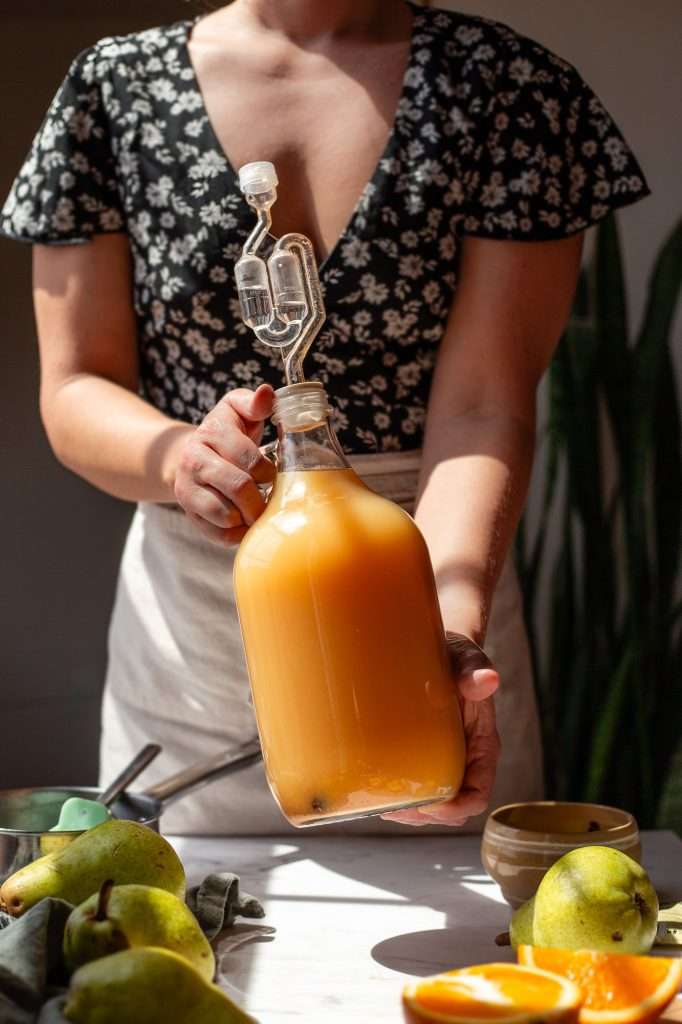



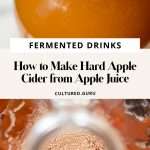
What ABV will this produce? And will it be shelf stable at room temp after being refrigerated for 3 weeks in bottles?
It should be 6 to 7%
It is not pasteurized like shelf-stable cider at the store and contains live microbes so it needs to be stored in the fridge.
Can you make this with fresh cider as well?
As in fresh pressed juice? yes, but you need to heat it to pasteurize it first.
I’m stoked to make this with our own apples! Can this store in the fridge longer than 3 weeks? Trying to gauge how much to make at a time. Thanks!
oh yes! it keeps in the fridge for a long time. I just like to “age it” in the fridge for three weeks before I start drinking it.
okay, this isn’t done yet, but I’m going to go ahead and give it 5 stars because I can tell it’s going to be great. I started it 14 days ago, and I just finished racking the cider for the first time, and now I have four weeks to wait before I bottle it. I want to just go ahead and bottle it, but I’ve also read elsewhere that the more it is aged the better it tastes, so I’ll just have to wait. it should be ready in 7 weeks!
I only have a gallon carboy as a gift, can I use this recipe or should I double it to fit the gallon?
you should double the recipe, so there isn’t too much headspace in the jug.
I can’t wait to try this but just wondering if you can skip the aging process and just go straight to bottling the cider with the honey?
I think you can try it, but it won’t taste as good without the aging step.
I’ve been fermenting my cider for 22 days now, there is still tons of activity in the airlock. Is this normal? Should I let it completely die down before rebottling it for aging? Thanks 🙂
Yes, it’s normal, especially if you used fresh/in-season apple juice. You can go ahead and rack it, then just put the airlock back on the jug.
I know I’m late to the party but a local orchard has their own pressed juice that is like to try to use. But it’s unpasteurized (they treat it with UV light) should I boil it to pasteurize it before? Or does the UV light do enough?
It may be okay without boiling, but If you skip heating it you may end up with some wild fermentation happening and some sour flavors.
Thankyou so much!
I just found your site and instagram – I’m loving it! A couple of questions about this recipe.
1. If doing this in a gallon jug, do you also double the water and brown sugar for the yeast starter? Do you recommend doing this even if the yeast packet recommends rehydrating at higher than room temp?
2. Would using ‘regular’ brown sugar cause issues (other additives, maybe)?
3. Can the ferment and aging be done in the same cool room temp area? Will this just mean slower fermentation?
4. What’s the reason for racking to another vessel for aging? Why not just leave the cider in the fermentation jug for 1-2 weeks, or until the bubbling stops, and then another 4 weeks for aging?
Sorry for all the questions, and thanks in advance for your time! It’s my first time homebrewing and it’s been so cool to nerd out!
Yes, if you want to make a full gallon, you will need to double all ingredients, since this is a half gallon recipe. The directions here is how I make my cider, I don’t follow the directions on the yeast packet.
As long as it’s pure sugar, with no preservatives or anti-caking agents, you can use it. organic sugar works best.
I think the initial fermentation should be at room temperature, the cooler it is the slower it will ferment.
Racking helps clear the cider and gets rid of the spent yeast. The spent yeast form a sediment in the bottom of the jug and if you leave the sediment in there without racking to a clean vessel, the flavor won’t be as good. Racking really helps the flavor so it doesn’t taste like yeast sediment.
Hi Kaitlynn,
I would like to make this recipe. I have collected a bunch of apples off our old apple tree here that i will lightly cook down and get juice from, but I want to be able to share cider with friends over the winter. How can I make a version that will still be good 3-4 months later?
Thank you!
Becca
this recipe will still be good 3-4 months later. It lasts in the fridge for a long time.
HI! I am super excited to try this recipe! I canned apple juice from our apples last year, what are you thoughts on this? Also have you ever tried to add another fruit, I seen you have a recipe for blood orange cider, I juiced raspberries this season and what are your thoughts on me adding this?
yes! you can use your canned apple juice. And yes! I’m always experimenting with seasonal fruits in cider. Raspberry would be delicious!
Hey Kaitlynn, I started my first batch on the 25 and I’m having great fermentation success so far. Curious do you stir the brew during the initial fermentation process or just leave it still? I’ve heard mixed things about aerating brews throughout the process to support the yeast activity. Is that something you’d recommend every so often?
Thanks!
no you don’t stir it. You leave it airlocked. You’ll aerate it a bit naturally through the racking process.
Hello, thank you for sharing this recipe. We have bottled our first batch and have tried it at 5-days, and then again at 7-days to check on the carbonation, but both times it has been very little carbonation, if at all. Could we have done something wrong through the process?
You didn’t do anything wrong. It might just need some more time to carbonate, especially if its cold in your home. You can try adding a tiny bit more honey and leaving it for longer, maybe 10-12 days. Just be careful, as adding too much honey can cause too much pressure in the bottle.
My first cider making experience was great
Awesome! So glad your first cider went well!
Please please please add something about temperature shock. Heat a glass carboy in hot water before dumping in boiling water. My 1 gallon cracked once I poured in boiling water. Have to wait for a new one to try this recipe
Thanks for the feedback! I’ll add a note. it must be cold where you are! It takes quite a temperature differential to break glass.